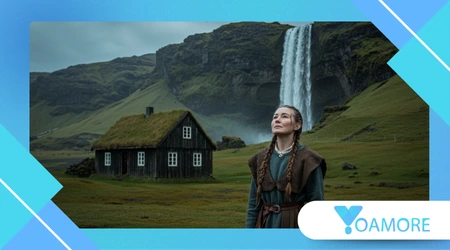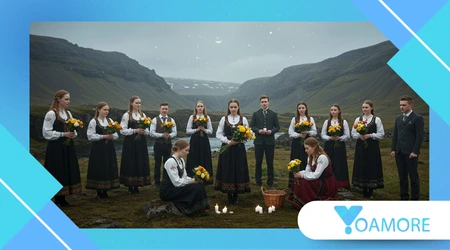Los elfos islandeses: una microcultura entrelazada con la naturaleza

Los creyentes en los elfos de Islandia representan una microcultura única donde el folclore, el medio ambiente y la identidad se fusionan en un todo inseparable.
Anuncios
Este sistema de creencias no sólo influye en el tejido social de Islandia, sino que también da forma a las prácticas ecológicas y a las industrias del turismo.
Este artículo explora cómo funciona esta cultura distintiva, su relevancia moderna y el impacto sutil pero profundo que continúa teniendo en la vida islandesa.
Desde el folclore profundamente arraigado hasta la planificación urbana moderna, la presencia de elfos (o personas ocultas) sigue siendo una fuerza activa en Islandia.
La narrativa no trata sólo de seres míticos, sino de cómo la creencia fomenta el respeto por la naturaleza y la comunidad.
Anuncios
Cubriremos sus orígenes, dinámica social, implicaciones ambientales, reflexiones económicas y resonancia psicológica, combinando datos verificados y análisis reflexivos.
Los orígenes de la creencia en los elfos en Islandia: una tradición viva arraigada en la naturaleza
La creencia en los elfos, o “huldufólk” (gente oculta), no es simplemente una historia contada por los abuelos; es una tradición viva profundamente arraigada en la identidad islandesa.
Los creyentes en los elfos de Islandia Observa el accidentado paisaje (campos de lava, rocas cubiertas de musgo y densos bosques de abedules) como si estuviera habitado por espíritus que merecen respeto.
Históricamente, el aislamiento y el duro entorno de Islandia propiciaron una rica tradición oral. Estas historias cumplían funciones prácticas y espirituales, previniendo a la gente de perturbar la naturaleza innecesariamente.
Este respeto por los sitios naturales se tradujo en esfuerzos de preservación mucho antes del ambientalismo moderno.
Una analogía podría ayudar: así como un marinero confía en las estrellas para navegar en mares inciertos, los islandeses confían en estos cuentos ocultos para navegar por su tierra con reverencia y cuidado.
Esta creencia fomenta una mentalidad que combina la reverencia con la conciencia ecológica.
+ El día que la niebla londinense se volvió mortal: un análisis histórico del riesgo urbano
Narración y continuidad cultural: más que un mito
La narración actúa como vehículo que transporta esta microcultura a través de las generaciones. A diferencia de muchas tradiciones en decadencia, Los creyentes en los elfos de Islandia adaptan continuamente sus cuentos a la vida contemporánea.
Por ejemplo, las historias modernas podrían incluir elfos interactuando con habitantes de la ciudad o influyendo en decisiones cotidianas como los planes de construcción.
La flexibilidad de estas narrativas les permite prosperar incluso en entornos urbanos.
Esta dinámica cultura oral contribuye a mantener los valores comunitarios arraigados en el respeto por las fuerzas invisibles. Sirve como un sutil recordatorio de que los humanos somos parte de un ecosistema más amplio.
La narrativa también fomenta la formación de la identidad. Los jóvenes islandeses que asisten a talleres de folclore aprenden no solo sobre geología y ecología, sino también sobre cómo la tierra los conecta con las generaciones pasadas y futuras, fomentando un sentido de pertenencia.
Lea también: Los susurradores de camellos de Rajastán: Un vistazo a sus señales secretas
Cohesión social y ética ambiental

La creencia en los elfos va más allá de la superstición: crea cohesión social y enmarca un trato ético a la naturaleza. En muchas comunidades islandesas, especialmente en las rurales, el folclore guía la toma de decisiones locales.
Un ejemplo famoso es el de un proyecto de construcción de una carretera que se retrasó porque los trabajadores descubrieron una gran formación rocosa considerada como la vivienda de un elfo.
Respetar esta creencia ayudó a mantener la confianza y previno conflictos sociales.
Esta integración del mito y las normas sociales fomenta la responsabilidad colectiva. Los creyentes en los elfos de Islandia A menudo se ven a sí mismos como guardianes no sólo de las historias, sino también del entorno que esas historias protegen.
El aspecto económico: el turismo y la preservación cultural
El misterio que rodea a los elfos se ha convertido en un activo económico. La industria turística islandesa capitaliza este folclore ofreciendo "tours guiados de elfos", que combinan geología, historia y mitos.
Los visitantes obtienen una perspectiva única del paisaje de Islandia, tanto de sus características naturales como de sus historias culturales.
Estos tours apoyan las economías rurales, promueven el turismo sostenible y fomentan la conciencia ambiental entre los turistas.
Al interactuar con la microcultura de Los creyentes en los elfos de IslandiaLos visitantes desarrollan empatía por los esfuerzos de conservación locales.
Además, los artesanos locales crean recuerdos con temática de elfos y los festivales celebran este patrimonio cultural, reforzando el vínculo entre la economía y el folclore.
+ Antiguos rituales que aún se practican en aldeas remotas
Desarrollo urbano y desafíos modernos
A medida que Islandia se urbaniza, a veces surgen tensiones entre la modernización y la tradición.
Sin embargo, los planificadores consultan cada vez más a expertos en folclore para evitar alterar los supuestos hábitats de los elfos, lo que refleja una integración de la creencia en las decisiones prácticas.
Este enfoque se alinea con los principios del desarrollo sostenible, donde los factores sociales y ambientales pesan junto con los intereses económicos.
Los creyentes en los elfos de Islandia ilustrar cómo el patrimonio cultural puede orientar la planificación de infraestructura contemporánea.
Resonancia psicológica: el folclore como ancla emocional
La creencia en los elfos proporciona consuelo psicológico en una época dominada por el rápido cambio tecnológico y la ansiedad ambiental.
Para muchos islandeses, estos cuentos ofrecen un ancla emocional: una conexión con algo duradero y significativo.
La analogía de un ancla que estabiliza un barco a la deriva es adecuada: el folclore estabiliza la psique al arraigar a los individuos en un paisaje cultural compartido.
Datos reales: La prevalencia de la creencia en los elfos
Una importante encuesta realizada por la Junta de Turismo de Islandia en 2012 encontró que aproximadamente el 71% de los islandeses afirmaron haber visto o sentido la presencia de elfos o personas ocultas.
Esta cifra asciende a aproximadamente 10% entre los islandeses más jóvenes de entre 18 y 29 años, lo que demuestra la persistencia y adaptabilidad de la creencia.
| Grupo de edad | Porcentaje de quienes creen en los elfos |
|---|---|
| 18–29 | 10% |
| 30–49 | 6% |
| 50+ | 5% |
Estos datos ilustran que Los creyentes en los elfos de Islandia no se limitan a las generaciones mayores o a las zonas rurales, sino que mantienen su relevancia entre los grupos demográficos.
Perspectivas académicas y antropología cultural
El antropólogo Terry Gunnell, un respetado estudioso del folclore islandés, destaca que la creencia en el pueblo oculto fomenta la resiliencia de la comunidad y un fuerte sentido de identidad ambiental.
Sostiene que esta microcultura trasciende la superstición y actúa como marco para la gestión ecológica y la cohesión social.
Su trabajo subraya cómo interactúan el mito y el medio ambiente, revelando el profundo impacto que tales creencias tienen en las prácticas humanas sostenibles.
Reflexiones sobre el escepticismo: ¿mito o ecología moderna?
Es tentador descartarlo Los creyentes en los elfos de Islandia como una superstición pintoresca, pero al hacerlo se pasan por alto las funciones más profundas que cumplen estas creencias.
Actúan como vehículos para el apego al lugar, la ética ambiental y la confianza social.
Esta microcultura fomenta comportamientos alineados con la conservación, la participación comunitaria y el respeto por el patrimonio, ilustrando cómo el mito puede tener efectos pragmáticos en el mundo real.
Ejemplo práctico: Respeto al folclore en la planificación urbana
En 2014, una proyecto de construcción cerca de Reikiavik Se detuvo cuando los trabajadores descubrieron una roca cubierta de musgo que los lugareños creían que pertenecía a elfos domésticos.
El desarrollador colaboró con los ancianos de la comunidad y expertos en folclore para rediseñar el sitio, evitando perturbaciones.
Esta cooperación preservó la buena voluntad de la comunidad y demostró cómo la integración de creencias microculturales puede mejorar el desarrollo sostenible.
Ejemplo práctico: el folclore en la educación
Varias escuelas islandesas han integrado el folclore en sus programas de estudio, utilizando historias de elfos para enseñar geología, ecología e historia cultural.
Los estudiantes participan en excursiones que combinan la observación científica con la narración de cuentos.
Este enfoque educativo profundiza el compromiso y ayuda a las generaciones más jóvenes a conectarse con su entorno y su patrimonio cultural, asegurando la continuidad de Los creyentes en los elfos de Islandia microcultivo.
¿Por qué importa esto? Una reflexión retórica
¿No es fascinante cómo la creencia en guardianes invisibles puede promover un cuidado tangible del medio ambiente y la sociedad?
Esta pregunta nos invita a repensar los límites entre el mito y la realidad, mostrando que el folclore sigue siendo una herramienta poderosa para moldear el comportamiento.
Conclusión: El legado perdurable de los creyentes elfos de Islandia
Los creyentes en los elfos de Islandia Encarnan una microcultura donde el mito y el medio ambiente se cruzan, influyendo en las normas sociales, la actividad económica y la ética ecológica.
Su continua relevancia afirma que las narrativas culturales moldean nuestra relación con la naturaleza de maneras profundas.
Preguntas frecuentes
1. ¿Las creencias sobre los elfos son exclusivas de Islandia?
Si bien existen creencias similares en seres ocultos en todo el mundo, el folclore de Islandia es particularmente rico y está integrado en la vida cotidiana, lo que hace que su cultura de elfos sea distintiva.
2. ¿La mayoría de los islandeses creen realmente en los elfos?
Las encuestas muestran que una minoría afirma tener experiencia directa, pero el respeto por el folclore de los elfos está muy extendido y a menudo combina orgullo cultural y ética medioambiental.
3. ¿Cómo afectan las creencias de los elfos al turismo de Islandia?
Mejoran el turismo atrayendo visitantes interesados en experiencias culturales auténticas, apoyando las economías locales y promoviendo la conciencia ambiental.
4. ¿Puede el folclore influir en las políticas ambientales modernas?
Sí. Como se ve en los casos de planificación urbana, las consideraciones folclóricas con frecuencia dan forma al desarrollo para respetar la naturaleza y los valores de la comunidad.
